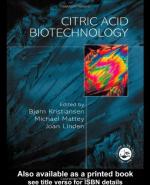|
This section contains 308 words (approx. 2 pages at 300 words per page) |
Citric acid is an organic (carbon based) acid found in nearly all citrus fruits, particularly lemons, limes, and grapefruits. It is widely used as a flavoring agent, preservative, and cleaning agent. The COOH group is a carboxylic acid group, so citric acid is a tricarboxylic acid, possessing three of these groups.
Citric acid is produced commercially by fermentation of sugar by several species of mold. As a flavoring agent, it can help produce both a tartness [caused by the production of hydrogen ions (H +)] and sweetness (the result of the manner in which citric acid molecules "fit" into "sweet" receptors on our tongues). Receptors are protein molecules that recognize specific other molecules.
Citric acid helps to provide the "fizz" in remedies such as Alka-Seltzer trademark. The fizz comes from the production of carbon dioxide gas that is created when sodium bicarbonate (baking soda) reacts with acids. The source of the acid in this case is citric acid, also helps to provide a more pleasant taste.
Citric acid is also used in the production of hair rinses and low pH (highly acidic) or slightly acidic shampoos and toothpaste. As a preservative, citric acid helps to bind (or sequester) metal ions that may get into food via machinery used in processing. Many metals ions speed up the degradation of fats. Citric acid prevents the metal ions from being involved in a reaction with fats in foods and allows other preservatives to function much more effectively. Citric acid is also an intermediate in metabolic processes in all mammalian cells. One of the most important of these metabolic pathways is called the citric acid cycle (it is also called the Krebs cycle, after the man who first determined the role of this series of reactions). Some variants of citric acid containing fluorine have been used as rodent poisons.
|
This section contains 308 words (approx. 2 pages at 300 words per page) |


